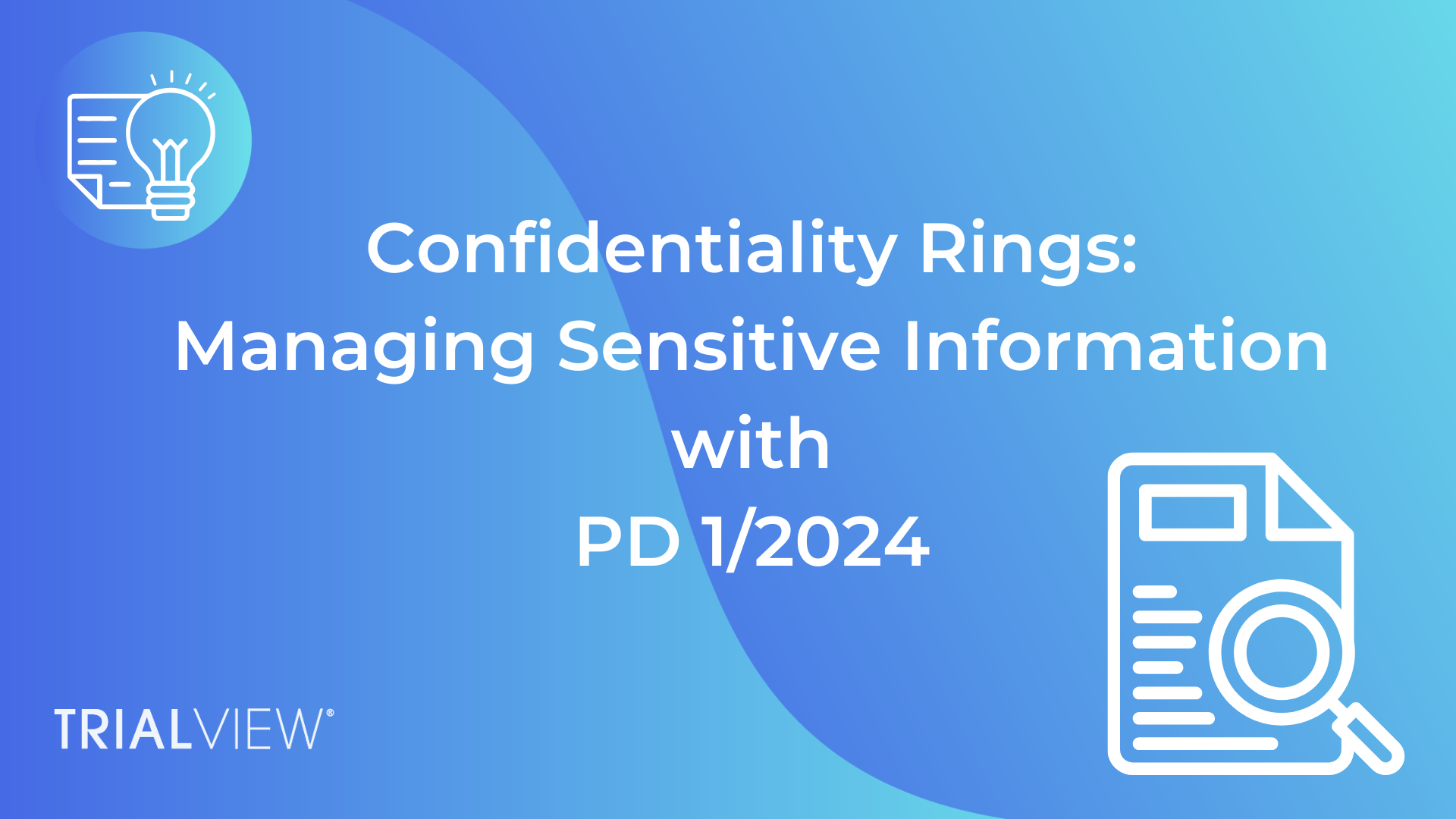New Practice Direction on Confidentiality Rings: PD 1/2024
PD 1/2024 seeks to manage sensitive information at the Competition Appeal Tribunal.
Date : 16/02/24


The CAT has issued a practice direction seeking to manage confidential information, which will be applicable to all cases which have their first CMC (case management conference) after 4th January 2024.
We look at the fundamentals of this new PD and examine how the right technology can offer a more efficient solution to the rising challenge of complex competition cases.
What is PD 1/2024?
Practice Direction 1/2024 addresses the establishment of confidentiality rings, a mechanism allowing restricted distribution of documents containing sensitive information. The direction acknowledges the growing complexity of confidentiality rings, which often include both “inner” and “outer” rings, posing challenges in document disclosure, and beyond. The aim is to streamline the management of confidential information while ensuring compliance with Rule 101(1) of the Tribunal’s Rules. Rule 101(1) requires specific reasons (both as to the nature of the sensitivity of the information contained in the documents and the adverse effect of disclosure) to be given for each request for confidential treatment of a document.
The Starting Point: Rule 102
Rule 102 sets the baseline for document protection in Tribunal proceedings, stipulating that a party receiving a document may only use it for the purposes of the proceedings, and not for any extraneous purpose, such as commercial decision-making.
In essence, Rule 102 can be viewed as an “outer ring” confidentiality ring. Para 7 of the PD states;
“Accordingly, the Tribunal’s starting point will be that, at least for the purposes of disclosure by the parties, the protection afforded by Rule 102 equates to an “outer” confidentiality ring, and that the creation, use and content of a formal confidentiality ring will have to be justified. The Tribunal will, at an early stage in any proceedings, be prepared to consider fortifying the protection conferred by Rule 102 in an appropriate case.”
Additional Protection and Early Consideration
The practice direction highlights the duty of parties to give early consideration to confidentiality issues likely to arise in a case. It distinguishes between cases where Rule 102 restrictions suffice, and situations requiring additional measures, such as confidentiality rings or specific orders governing document use. The nature of the case and the sensitivity of information guide these considerations.
The Confidentiality Protocol
To facilitate the management of confidentiality issues, parties are encouraged to develop a confidentiality protocol before the first CMC. This protocol should address the nature and extent of sensitive information; the grounds for claims to confidentiality; processes for challenging claims; and the establishment of confidentiality rings. It serves as a proactive tool for parties to collaboratively navigate potential challenges related to confidential data.
The new practice direction zones in on the need for parties to justify whether specific confidentiality arrangements are really needed, and they are encouraged to do so at a very early stage. The PD makes it very clear that there will be costs implications if parties fail to reach a workable solution.
The role of Technology
With the exponential increase in digital data, the need to use technology at a much earlier stage of proceedings continues to grow in parallel. Technology now plays a crucial role in efficiently identifying, categorising, and safeguarding sensitive information within the framework of confidentiality rings.
As acknowledged by the CAT, the increasing complexity of data, and subsequently of confidentiality rings, requires collaboration, early case management and the need for a proactive and technology-driven approach. The integration of AI, when aligned with the pragmatic principles outlined in the practice direction, offers law firms the opportunity to navigate confidentiality challenges more effectively.
At TrialView, we have designed technology specifically for this challenge. This Technology has been employed in hearings before before the CAT.
- Robust user authentication protocols. The most confidential information is only visible to parties within a court ordered inner confidentiality ring, while less sensitive (but still confidential) material can be visible to those in an outer confidentiality ring. Users who are not members of the inner or outer confidentiality rings are able to view redacted versions of confidential material.
- Permission settings facilitate the designation of users into teams and specific roles, with each role aligned to their individual membership of the confidentiality rings.
- Special controls ensure that a user will only have access to the version of the document they are entitled to see.
- Evidence presentation is designed so that different users see different versions of the same document simultaneously (based on the log in credentials).
- Version control facilitates consistency of pagination, structure, and tabbing.
- Dynamic watermarking ensures that exports and bundles contain the correct confidentiality designation, ensuring that any shared document can be traced back to source.
- Exports and bundles of documents can also be set to align to the recipient’s confidentiality ring membership.
To see how this worked out in practice, see our Case Study with Fieldfisher.
We will be running a webinar on this topic with the SCL, so do keep an eye out for updates
Related Blogs


BBPC – The use of AI in commercial dispute resolution
TrialView were delighted to sponsor the BBPC Forum. The Master of the Rolls, Sir Geoffrey Vos, and an expert panel discussed how AI is being used in dispute resolution today and how this may look in the future.
- Written By : Eimear Mccann
- Date : 02/08/24


Timeline Creation: TrialView Perspective
With our AI functionality, we balance innovation with practical tools to help make your case preparation easier. One of our newest evolutions is Timeline Creation functionality.
- Written By : Eimear Mccann
- Date : 19/07/24
Take The Next Step.
If you’re wondering about how we can help you focus more on outcomes, and worry less about hearing prep, book a tailored demo or give us a call.


Get In Contact
Want to find out more? Get in touch to find out why TrialView is the platform of choice for dispute resolution.

